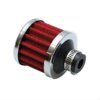Indycars
Well-Known Member
2old2fast & Indycars – I thought that you only needed a return line with fuel injection???
In your drawing you state a Holley Blue pump which puts out 14 psi, therefore you will need a pressure regulator. This type of pressure regulator uses a return line that go back to the tank.
The Holley Red pump is internally regulated and puts out 7 psi at the pump, so hopefully you get 4-5 psi at the carburetor. I used the red previously and had no problems with it when the engine put out 300 HP. Since I have now built an engine that should put out about 500 HP, I wanted a better more stable fuel pressure that the external regulator will give me. Also you are setting the pressure at the carburetor where it's important, not guessing at what pressure is needed at the pump which is located at the back by the tank.
Indycars – Thanks for the spreadsheet // What is the restriction on the Mallory 4307M? // The Fuel gage that you spec'ed does not appear to be liquid filled //Where does the Vent Filter attach?
You are welcome, glad it could help more than just myself!
I will have to measure if I can without taking it apart. I ordered the Mallory because it came with AN fittings which are not cheap, so the price of the regulator was actually less for me since I didn't have to buy the fittings separately.
Right, hard to remember exactly, but I think temperature effects a liquid filled gauge and has to be calibrated. Someone will correct me if I'm wrong on that, but that's the best my memory can do right now.

In the picture above in a previous post, you can see where two bungs were welded on, one of those is for the vent and the other for the return line. The cap is not vented, so I had to provide it. A short line of about 6 inches will run to a small filter like below.

You might find this helpful about the different filters and again there is an Excel spreadsheet.
Are you going to use AN fittings in your setup???

Are you going to use AN fittings in your fuel system???
In your drawing you state a Holley Blue pump which puts out 14 psi, therefore you will need a pressure regulator. This type of pressure regulator uses a return line that go back to the tank.
The Holley Red pump is internally regulated and puts out 7 psi at the pump, so hopefully you get 4-5 psi at the carburetor. I used the red previously and had no problems with it when the engine put out 300 HP. Since I have now built an engine that should put out about 500 HP, I wanted a better more stable fuel pressure that the external regulator will give me. Also you are setting the pressure at the carburetor where it's important, not guessing at what pressure is needed at the pump which is located at the back by the tank.
Indycars – Thanks for the spreadsheet // What is the restriction on the Mallory 4307M? // The Fuel gage that you spec'ed does not appear to be liquid filled //Where does the Vent Filter attach?
You are welcome, glad it could help more than just myself!
I will have to measure if I can without taking it apart. I ordered the Mallory because it came with AN fittings which are not cheap, so the price of the regulator was actually less for me since I didn't have to buy the fittings separately.
Right, hard to remember exactly, but I think temperature effects a liquid filled gauge and has to be calibrated. Someone will correct me if I'm wrong on that, but that's the best my memory can do right now.
In the picture above in a previous post, you can see where two bungs were welded on, one of those is for the vent and the other for the return line. The cap is not vented, so I had to provide it. A short line of about 6 inches will run to a small filter like below.

You might find this helpful about the different filters and again there is an Excel spreadsheet.
Are you going to use AN fittings in your setup???
Are you going to use AN fittings in your fuel system???







